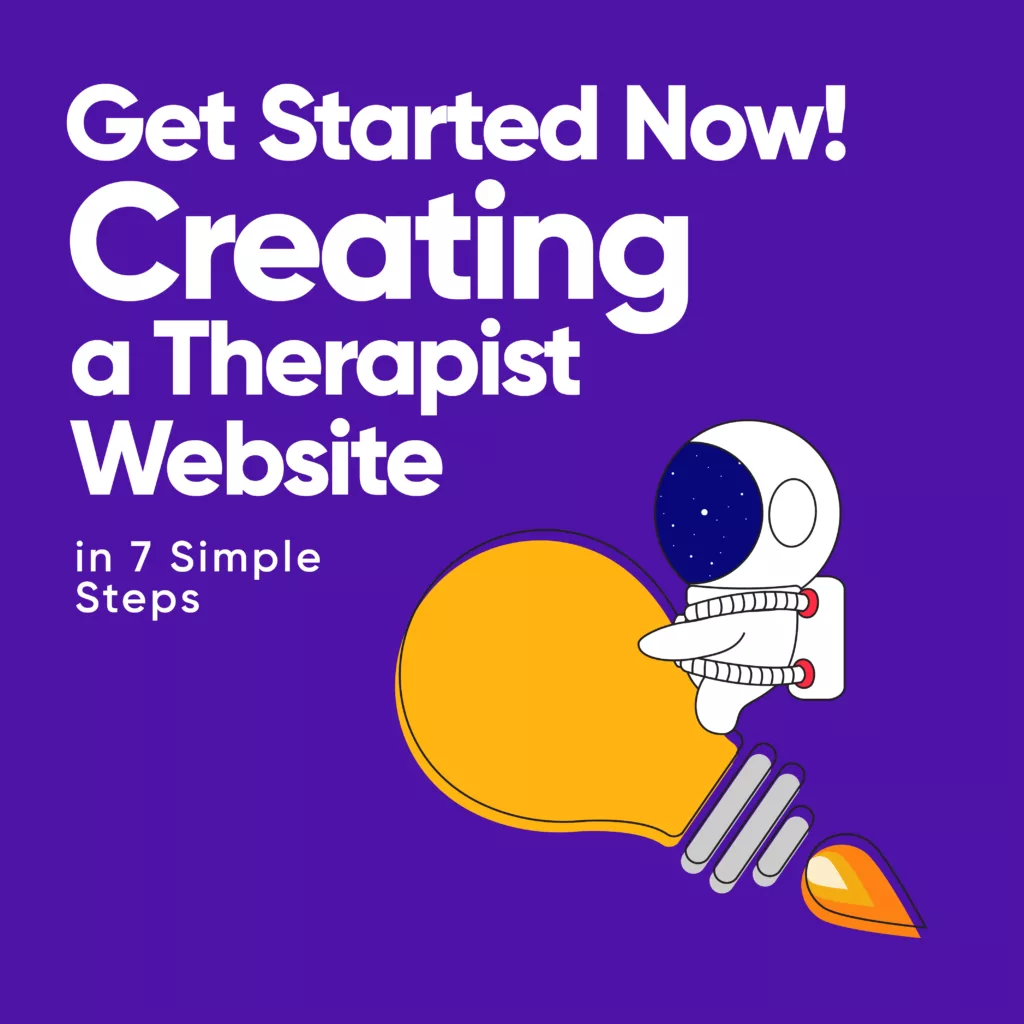7 Tips from a Therapist Website Builder! Simple Steps When Creating A Therapist Website
Create Therapist Website
Are you a therapist or psychologist looking to make your mark in the digital world?
Creating a therapist website may seem like a formidable task, but rest assured, it’s an achievable goal.
As a therapist website builder here’s a step-by-step guide to therapist website creation, we’ll walk through the process together, breaking it down into seven straightforward steps.
No need for tech jargon or design expertise—just your determination and our guidance to get you started.

I'm Sarah Gershone, and my passion is helping professionals like you craft strategically designed websites that connect with your clients.
Step 1: Clarify Your Website’s Purpose
Before you dive into the technicalities, let’s define why you want a therapist website. Think of this step as the foundation upon which your entire website will be built. Before we get into the nitty-gritty technical stuff, it’s crucial to have a clear understanding of why you want a therapist website.
So, why do you want one? Let’s break it down.
First, consider whether you want your website to serve as an information hub. Do you want it to be a place where potential clients can learn about your services, your expertise, and your approach to therapy? If the answer is yes, that’s a fantastic starting point.
Next, ponder if you’d like your website to help you establish connections with potential clients. Do you want it to be a platform where people can reach out to you, ask questions, and eventually book appointments? If that’s your goal, it’s an excellent choice.
Lastly, think about whether you’d like to use your website to share valuable resources. Do you have articles, guides, or tools that could benefit your clients or others interested in therapy? If you want to be a resource hub, that’s a commendable purpose too.
This clarity will guide your choices in terms of content, design, and functionality as we move forward.
So, take a moment to define your website’s purpose, and we’ll continue our journey to create a therapist website that suits your goals and needs.
Step 2: Secure Your Domain and Hosting
Now, let’s move on to the second step in our journey of creating your therapist website: Securing Your Domain and Hosting. Think of this step as finding a physical location for your office. You need an address where clients can reach you, right?
Well, in the online world, your website needs an address too, and that’s your domain name.
So, what’s a domain name?
It’s basically your website’s online address, like “www.YourTherapistPractice.com.” It’s how people will find you on the internet.
Now, choosing a domain name might seem like a small detail, but it’s more important than you might think. You want it to reflect your practice and be easy for clients to remember. Just like you’d want your office location to be accessible and memorable.
Once you’ve picked your domain name, you’ll need a place to host your website. Think of hosting as renting office space in a building. You need a reliable and secure place to keep all your website files. There are several hosting providers out there, like Bluehost or SiteGround, that offer dependable services.
So, to sum it up, in this step, you’re giving your therapist website a digital address and a safe place to call home on the internet. It’s like setting up shop in a new office building, ensuring that your online practice has a solid and secure foundation.
With your domain and hosting sorted out, we’re making great progress on our website creation journey.
Step 3: Select an Easy To Use Platform
You might be thinking, “Do I have to code from scratch to build a website?”
The good news is, no, you don’t!
You see, building a website today is much like assembling furniture from a well-designed kit. It’s all about choosing the right pieces and putting them together.
That’s where website builders like WordPress, Wix, or Squarespace come in. These are like the kits that make building your website a breeze. They provide you with ready-made templates, so you don’t need to be a coding genius. You simply pick a template that suits your style and preferences. Think of it as selecting the design and layout for your office space. You’d want it to be welcoming and reflective of your practice, right? Similarly, you’ll want to choose a website builder that aligns with your vision for your therapist website.
So, in this step, we’re simplifying the website creation process by using user-friendly tools that do most of the heavy lifting.
It’s like having a well-organized kit with clear instructions to put together your office space, but in the digital realm.
With the right website builder, you’ll be well on your way to bringing your therapist website to life without the need for coding skills.
Step 4: Design Your Website
Now, let’s dive into the exciting fourth step:
Designing Your Website. This is where you get to let your creativity shine while maintaining a professional look and feel. Imagine it as the interior design of your office space.
You’d want it to be welcoming and representative of your practice, right?
Well, your website is your digital office, and it should make the same impression.
Start by selecting a clean and professional template. This is like choosing the foundational style for your office—modern, classic, or something else entirely.
Then, think about the colors and fonts. These are like the paint and furniture in your office. They should reflect your practice’s identity and create a comfortable environment for your visitors.
Keep the layout straightforward and user-friendly, just like you’d arrange your office for ease of navigation.
Make sure visitors can easily find the information they need. Your goal is to create a digital space that’s not only visually appealing but also functional and welcoming.
In essence, this step is about crafting the visual and structural elements of your therapist website, making it a reflection of your practice and a comfortable space for your online visitors. So, let your creativity flow within the boundaries of professionalism, and you’ll be well on your way to a beautifully designed website.
Step 5: Craft Engaging Content
Content forms the core of your therapist website.
Your goal here is to communicate with clarity and simplicity. Use plain and accessible language, avoiding jargon or complex terms, just as you would when explaining your approach to a client.
Describe your services in a way that’s easy for anyone to understand, and highlight your qualifications to build trust.
Don’t forget to share how you can assist potential clients on their journey towards healing and well-being. Think of this as a conversation you might have with a client during an initial consultation, where you explain your therapeutic approach and how it can benefit them.
And here’s a crucial element: include a clear call-to-action. Encourage visitors to take the next step, whether it’s contacting you for more information or booking an appointment.
Crafting engaging content is about providing valuable information, establishing trust, and making it easy for visitors to take action. It’s like having an informative and friendly conversation with every person who walks into your office, right on your therapist website.
And if you want to know more about enhancing your content strategy, head over to this blog, “How to Create an SEO Content Marketing Strategy For Your Private Practice.” It’s packed with valuable insights into various content types that can boost your website’s impact.
Step 6: Share Contact Info
Make it a breeze for potential clients to reach out by prominently displaying your contact information.
Include your phone number, email address, and perhaps even a user-friendly contact form. It ensures that anyone who visits your website can reach out to you without any hassle.
Whether someone prefers to give you a call, send an email, or use a contact form, you want to provide all these options.
The idea here is simple yet vital—easy access. By making your contact information easily accessible, you’re removing any barriers for potential clients who are interested in your services.
Step 7: Optimize for Search Engines (SEO)
Now, SEO might sound a bit technical, but it’s like making sure your office is listed in the right directory so that people can find you easily.
When someone searches for therapy services in your area on Google, you want your website to pop up in the results.
To make this happen, you’ll integrate relevant keywords into your website’s content. These keywords are like the specific words people might use when searching for a therapist, such as “therapist services” or “psychologist in [your location].” You’ll strategically place these keywords in your content, especially in headings and meta descriptions.
Why is this important?
Well, think of it as increasing your visibility in the online world. When potential clients are looking for therapy services in your area, you want your website to be among the top results they see. It’s like ensuring that your office is listed right at the top in the directory, so you get more foot traffic.
At Strong Roots Web Design, we’ve helped many clients optimize their websites for better results. By implementing effective SEO strategies, we’ve seen websites climb up the search engine rankings and attract more visitors. It’s like having a prime location for your office, right where people are searching.
Curious to learn more? Check out our blog, “Unlocking the Power of SEO Keywords for Therapists,” where we explore understanding your audience’s language and how using the right phrases can make your website more discoverable.
Considering Professional Help?
If you’re thinking, “I’d rather have a professional handle this for me,” don’t worry.
Strong Roots Design is the perfect solution to bring your therapist website to life.
Here’s our process:
- Discovery
We kick off by having a thorough conversation with you. We want to know everything about your clients and your practice. This in-depth understanding ensures that your new website truly reflects your values and mission, making it a genuine representation of your practice.
- Content Creation
Using the valuable insights we gather during our discovery phase, we dive into crafting compelling content. This content authentically represents your practice, making it a powerful tool for connecting with new clients and nurturing the growth of your practice.
- Design and Build
This is where the magic unfolds. Your new website starts to take shape, and our design experts work their wizardry to bring your vision to life. We pay meticulous attention to every detail to ensure your website is not only visually appealing but also user-friendly.
- Feedback
Your satisfaction is our top priority. We value your input, and you’ll have plenty of opportunities to review our work and provide feedback. We’re committed to making adjustments until everything aligns perfectly with your vision, ensuring that you’re thrilled with the final result.
- Live Website!
The moment you’ve eagerly awaited arrives—your new website goes live! Feel free to share it proudly with friends and family, and watch as it becomes an incredible ambassador, spreading the word about the essential work you do.
Why Choose A Professional Therapist Website Builder?
Experience Matters
We’ve done this a lot. We’ve made therapist websites that not only look good but also work great. We’ve seen websites improve, and our clients’ practices grow online.
Saves Time
Building a website can take time, especially if you’re new to it. With pros like us, things move faster. We know website stuff well, so your site goes live without long waits.
SEO Expertise
Remember making your site show up on Google? It’s called SEO, and it can be tricky. We’re experts at it, so your site gets found by people searching for therapy services.
Less Stress
Starting online can be stressful. With us, it’s easier. We guide you, fix problems, and make sure it all goes smoothly.
Whether you decide to take on the creation of your therapist website independently or enlist the support of professionals like Strong Root Design, your online presence is a valuable asset.
Your therapist website is more than just a static online presence; it’s a dynamic reflection of your unwavering commitment and dedication to helping others on their journey to well-being.
As a long-time therapist website builder, should you have any questions or require additional guidance throughout this step-by-step guide to therapist website creation, please don’t hesitate to reach out.
Book a call with me today, and let’s start shaping your therapist website into a powerful tool for connecting, inspiring, and making a positive impact in the lives of others.
Your digital journey has begun, and we wish you nothing but success in your mission to help and heal.
Related Reads for Starting A Therapist Website
- Best Ecommerce Solutions for Small Business and Therapy Practice Websites
- Custom vs template website For Your Therapy Practice
- Tips on Website Design For Mental Health Professionals
- Advanced Features for Psychiatry Practice Websites
- The Benefits and Drawbacks of a Counseling Website Template: A Comprehensive Guide
- Web Design for Therapists and Healers
- 4 Ways to Identify Web Design Goals for Your Therapists Website
- Web Design for Psychologists
- Benefits of Getting Customized Therapy Website Builder Services
- Website For Forensic Psychology Practice
- Best Practices for Psychologist Web Design
- Building a Therapist Website That Works
- Customized Websites for Child Therapists
- User-Friendly Website Templates For Therapists
- Photos for Your Therapy Website | Counseling Stock Photos
- 4 Factors to Consider When Choosing the Best Mental Health Website Design
- Private Practice Therapist Websites: Secrets to Success
- Therapist Websites: 8 Myths Every Therapist Should Know!
- Affordable Website Development for Counseling Professionals
Need any of the following?
Here are some Sample Websites We’ve Created:
Check out our Portfolio for more!
Hi! I’m Sarah.
I help counselors and therapists have a bigger impact on the world through better client connection. I do this by creating beautiful visuals and strategically designed websites.


